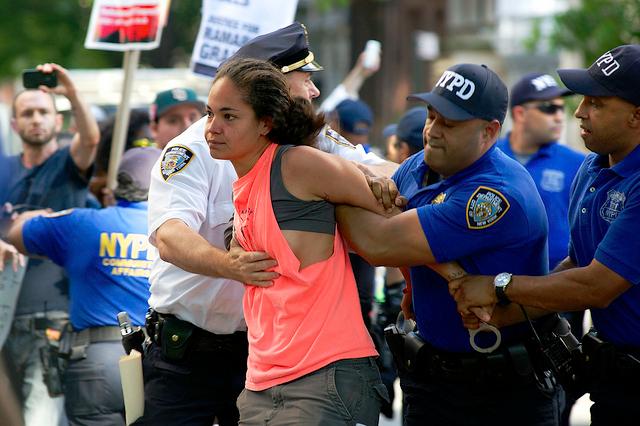Stop-and-frisk policy not unique to New York
A woman is arrested during a silent march against stop-and-frisk on June 17, 2012. (Photo courtesy of Flickr user Alangreig.)
In New York City, the law enforcement practice known as stop-and-frisk was found to be in violation of the fourth and fifteenth constitutional amendments, federal Judge Shira Scheindlin ruled on Monday.
But stop-and-frisk isn’t unique to New York. It’s practiced in many urban areas facing similar crime rates to New York City. Cecil Thomas, a former Cincinnati city councilman and policeman, said his city’s law enforcement used stop-and-frisk until it began to erode relations between the police and the community.
“Cincinnati, back in the early ’90s when I was a police officer. We saw a significant erosion in police-community relations simply because we were using something similar, a method very similar to what they’re doing in New York,” Thomas said. “A certain segment of the population was being profiled and as a result of that we had civil unrest, bricks being thrown, fires being set, and people were saying they’re frustrated with the way the police are policing in certain segments of the community.”
After an eruption of backlash in 2001, the U.S. Justice Department came to Cincinnati to oversee law enforcement procedures and practices. Thomas said the city’s chief was confident in the department’s work, going so far as to call Cincinnati a model of police success.
But the justice department, like Judge Scheindlin on Monday, thought differently. They found 115 issues and changes for the city’s law enforcement to make.
Thomas said crime rates in the city have decreased since.
Thomas also said he sees some of the erosion of 2001’s Cincinnati in today’s New York City.
“New York is going down a very dangerous slope,” Thomas said. “And yes, you may see early results saying that ‘Oh crime is down,’ but then all it takes is that spark.”
Mayor Michael Bloomberg’s administration claimed that stop-and-frisk helped save lives and has vowed to appeal the judge’s ruling.
“The fact that fewer guns are on the street now shows that our efforts have been successful,” said Bloomberg in response to the ruling. “And there is just no question that stop, question, frisk has saved countless lives. And we know that most of those lives saved, based on the statistics, have been black and Hispanic young men”
Stop-and-frisk came to Oakland in early 2013. The city saw a nearly 20 percent increase in violent crimes from 2011 to 2012 and a 26 percent increase of property crimes during that same period. The uptick in violent crime was the largest of any city in California.
Noel Gallo, an Oakland city councilman, echoed Bloomberg’s response saying that stop-and-frisk was a necessity to combat such heavy crime.
“We’re at the top of the charts when it comes to murders, robberies, burglaries, car thefts and so forth,” Gallo said. “So I believe that we need every tool necessary to be able to provide law enforcement in our neighborhood.”
